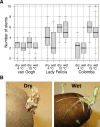Effect of wet storage conditions on potato tuber transcriptome, phytohormones and growth
- PMID: 31208336
- PMCID: PMC6580497
- DOI: 10.1186/s12870-019-1875-y
Effect of wet storage conditions on potato tuber transcriptome, phytohormones and growth
Abstract
Background: Stored potato (Solanum tuberosum L.) tubers are sensitive to wet conditions that can cause rotting in long-term storage. To study the effect of water on the tuber surface during storage, microarray analysis, RNA-Seq profiling, qRT-PCR and phytohormone measurements were performed to study gene expression and hormone content in wet tubers incubated at two temperatures: 4 °C and 15 °C. The growth of the plants was also observed in a greenhouse after the incubation of tubers in wet conditions.
Results: Wet conditions induced a low-oxygen response, suggesting reduced oxygen availability in wet tubers at both temperatures when compared to that in the corresponding dry samples. Wet conditions induced genes coding for heat shock proteins, as well as proteins involved in fermentative energy production and defense against reactive oxygen species (ROS), which are transcripts that have been previously associated with low-oxygen stress in hypoxic or anoxic conditions. Wet treatment also induced senescence-related gene expression and genes involved in cell wall loosening, but downregulated genes encoding protease inhibitors and proteins involved in chloroplast functions and in the biosynthesis of secondary metabolites. Many genes involved in the production of phytohormones and signaling were also affected by wet conditions, suggesting altered regulation of growth by wet conditions. Hormone measurements after incubation showed increased salicylic acid (SA), abscisic acid (ABA) and auxin (IAA) concentrations as well as reduced production of jasmonate 12-oxo-phytodienoic acid (OPDA) in wet tubers. After incubation in wet conditions, the tubers produced fewer stems and more roots compared to controls incubated in dry conditions.
Conclusions: In wet conditions, tubers invest in ROS protection and defense against the abiotic stress caused by reduced oxygen due to excessive water. Changes in ABA, SA and IAA that are antagonistic to jasmonates affect growth and defenses, causing induction of root growth and rendering tubers susceptible to necrotrophic pathogens. Water on the tuber surface may function as a signal for growth, similar to germination of seeds.
Keywords: Defence; Energy metabolism; Growth; Microarray; Oxygen; Potato; RNA-Seq; Storage; Tuber; Water.
Conflict of interest statement
The authors declare that they have no competing interests.
Figures









Similar articles
-
Physiological and molecular mechanisms associated with potato tuber dormancy.J Exp Bot. 2024 Oct 16;75(19):6093-6109. doi: 10.1093/jxb/erae182. J Exp Bot. 2024. PMID: 38650389 Free PMC article. Review.
-
Auxin: An emerging regulator of tuber and storage root development.Plant Sci. 2021 May;306:110854. doi: 10.1016/j.plantsci.2021.110854. Epub 2021 Feb 18. Plant Sci. 2021. PMID: 33775360 Review.
-
Altering trehalose-6-phosphate content in transgenic potato tubers affects tuber growth and alters responsiveness to hormones during sprouting.Plant Physiol. 2011 Aug;156(4):1754-71. doi: 10.1104/pp.111.179903. Epub 2011 Jun 13. Plant Physiol. 2011. PMID: 21670224 Free PMC article.
-
The physiological and molecular responses of potato tuberization to projected future elevated temperatures.Plant Physiol. 2024 Dec 24;197(1):kiae664. doi: 10.1093/plphys/kiae664. Plant Physiol. 2024. PMID: 39688842 Free PMC article.
-
Comparative transcriptome analysis coupled to X-ray CT reveals sucrose supply and growth velocity as major determinants of potato tuber starch biosynthesis.BMC Genomics. 2010 Feb 5;11:93. doi: 10.1186/1471-2164-11-93. BMC Genomics. 2010. PMID: 20137087 Free PMC article.
Cited by
-
Advances in the Modulation of Potato Tuber Dormancy and Sprouting.Int J Mol Sci. 2024 May 7;25(10):5078. doi: 10.3390/ijms25105078. Int J Mol Sci. 2024. PMID: 38791120 Free PMC article. Review.
-
Looking for Resistance to Soft Rot Disease of Potatoes Facing Environmental Hypoxia.Int J Mol Sci. 2024 Mar 28;25(7):3757. doi: 10.3390/ijms25073757. Int J Mol Sci. 2024. PMID: 38612570 Free PMC article. Review.
-
Overexpression of RpKTI2 from Robinia pseudoacacia Affects the Photosynthetic Physiology and Endogenous Hormones of Tobacco.Plants (Basel). 2024 Jul 6;13(13):1867. doi: 10.3390/plants13131867. Plants (Basel). 2024. PMID: 38999707 Free PMC article.
-
Physiological and molecular mechanisms associated with potato tuber dormancy.J Exp Bot. 2024 Oct 16;75(19):6093-6109. doi: 10.1093/jxb/erae182. J Exp Bot. 2024. PMID: 38650389 Free PMC article. Review.
-
Genome-wide identification and expression profiling of basic leucine zipper transcription factors following abiotic stresses in potato (Solanum tuberosum L.).PLoS One. 2021 Mar 12;16(3):e0247864. doi: 10.1371/journal.pone.0247864. eCollection 2021. PLoS One. 2021. PMID: 33711039 Free PMC article.
References
-
- FAOSTAT 2016. http://www.fao.org/faostat/en. Accessed 15 Oct 2018.
-
- Wegner LH. Oxygen transport in waterlogged plants. In: Mancuso S, Shabala S, editors. Waterlogging signalling and tolerance in plants. Berlin Heidelberg: Springer-Verlag; 2010. pp. 3–22.
-
- Voesenek LA, Bailey-Serres J. Flood adaptive traits and processes: An overview. New Phytol. 2015;206(1):57–73. - PubMed
-
- Pérombelon MCM. Potato diseases caused by soft rot erwinias: An overview of pathogenesis. Plant Pathol. 2002;51(1):1–12.
-
- Pérombelon MCM, Lowe R. Studies on the initiation of bacterial soft rot in potato tubers. Potato Res. 1975;18(1):64–82.
MeSH terms
Substances
Grants and funding
LinkOut - more resources
Full Text Sources

